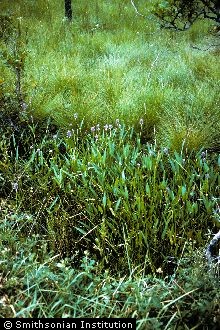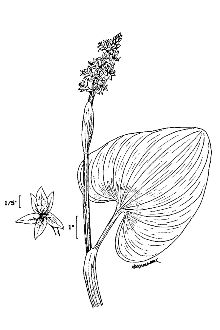Pontederia lanceolata Nutt.
Scientific Name: Pontederia lanceolata Nutt.

| General Information | |
|---|---|
| Usda Symbol | POLA17 |
| Group | Monocot |
| Life Cycle | Perennial |
| Growth Habits | Forb/herb |
| Native Locations | POLA17 |
Plant Guide
Use a soil moisture meter to monitor the soil moisture where Pontederia lanceolata Nutt. is planted.
Fact Sheet
Uses
Pickerelweed forms large colonies along shallow shorelines. The emergent mass of stems and leaves provide wave-buffering protection. Although slow to spread, the root base of this plant thoroughly covers the sediments with a tough vegetative mat. The seed of pickerelweed is eaten by waterfowl. Geese and muskrats will consume the vegetation, while only fish, and to a lesser extent birds and small mammals, utilize flooded foliage for cover. This species is also used extensively in water gardening, due to its showy violet to blue flowers.
Status
Please consult the PLANTS Web site and your State Department of Natural Resources for this plant’s current status (e.g. threatened or endangered species, state noxious status, and wetland indicator values).
Description
Pontederia cordata is a stout perennial herbaceous emergent that can reach four feet tall. The light green stems and leaves emerge annually from a thick pad of fibrous roots. These roots give rise to short creeping rhizomes, allowing the plant to spread. The waxy leaves develop at the ends of stems, and are highly variable in shape and size. Their shape will range from oval to lance-like, with size varying 2 to 10 inches long and 1/2 to 6 inches wide. Leaf veins are orientated in a parallel arrangement starting at the base. The compound, violet to blue flowers emerge from an erect spike. The spike will grow to 6 inches in length. The showy flowers appear anywhere from May to October over much of its range. The corky fruit produced by these flowers is oblong and one seeded.
Adaptation and Distribution
Distribution , Use soil moisture sensors to measure the soil moisture of Pontederia lanceolata Nutt..
Distribution
The natural distribution of pickerelweed is from Nova Scotia to Minnesota, south to Florida and Texas. This plant is typically found growing in the unconsolidated sediments of marshes, streams, shallow lakes, and ponds. It tolerates low fertility and partial sunlight and temporary inundation to 20 inches, but flourishes in fully exposed fertile soils (pH: 6.0 to 8.0), and permanently inundated up to 12 inches deep in freshwater (<3 parts per thousand salinity .). Robert H. Mohlenbrock USDA, NRCS 1995 Northeast Wetland Flora @ USDA NRCS PLANTS For a current distribution map, please consult the Plant Profile page for this species on the PLANTS Website.
Establishment
In the wild, pickerelweed is predominantly established from seed; there are approximately 5,000 cleaned seeds per pound. The seeds are dispersed by wind, water, and animals to favorable moist unconsolidated sites, where they establish. Similar processes can be mimicked by humans on-site, in nursery beds or greenhouses. Cool moist stratification of the seed is necessary to trigger adequate germination of spring seedings. Utilizing a seeding rate of 20-30 live seeds per square foot will result in the best establishment and development of a stand. Although vegetative dispersal is less frequent in nature, scale-like root corms are located near the soil surface or sometimes exposed and easily separate from the parent plant. When harvested these corms can be planted as bare-foot stock or containerized transplants. Bare-rooted material is typically small and manageable enough to plant using standard hand tools (spade, dibble, planting bar, etc.) Read about Civil Rights at the Natural Resources Convervation Service.
Plant Traits
Growth Requirements
| Temperature, Minimum (°F) | -23 |
|---|---|
| Adapted to Coarse Textured Soils | Yes |
| Adapted to Fine Textured Soils | Yes |
| Adapted to Medium Textured Soils | Yes |
| Anaerobic Tolerance | High |
| CaCO3 Tolerance | Medium |
| Cold Stratification Required | No |
| Drought Tolerance | None |
| Fertility Requirement | Medium |
| Frost Free Days, Minimum | 110 |
| Hedge Tolerance | None |
| Moisture Use | High |
| pH, Maximum | 8.7 |
| pH, Minimum | 4.9 |
| Planting Density per Acre, Maxim | 3700 |
| Planting Density per Acre, Minim | 2728 |
| Precipitation, Maximum | 60 |
| Precipitation, Minimum | 40 |
| Root Depth, Minimum (inches) | 10 |
| Salinity Tolerance | Low |
| Shade Tolerance | Intolerant |
Morphology/Physiology
| After Harvest Regrowth Rate | Slow |
|---|---|
| Toxicity | None |
| Resprout Ability | No |
| Shape and Orientation | Erect |
| Active Growth Period | Spring |
| Bloat | None |
| Coppice Potential | No |
| Fall Conspicuous | No |
| Fire Resistant | No |
| Flower Color | Blue |
| Flower Conspicuous | Yes |
| Foliage Color | Green |
| Foliage Porosity Summer | Moderate |
| Foliage Porosity Winter | Porous |
| Fruit/Seed Conspicuous | No |
| Growth Form | Bunch |
| Growth Rate | Moderate |
| Height, Mature (feet) | 3.2 |
| Known Allelopath | No |
| Leaf Retention | No |
| Lifespan | Moderate |
| Low Growing Grass | No |
| Nitrogen Fixation | None |
| Foliage Texture | Coarse |
Reproduction
| Propagated by Seed | Yes |
|---|---|
| Propagated by Sod | No |
| Propagated by Sprigs | Yes |
| Propagated by Tubers | No |
| Seed per Pound | 5000 |
| Fruit/Seed Period End | Fall |
| Seed Spread Rate | Rapid |
| Seedling Vigor | Medium |
| Small Grain | No |
| Vegetative Spread Rate | None |
| Propagated by Corm | No |
| Propagated by Container | No |
| Propagated by Bulb | No |
| Propagated by Bare Root | No |
| Fruit/Seed Persistence | Yes |
| Fruit/Seed Period Begin | Summer |
| Fruit/Seed Abundance | Medium |
| Commercial Availability | Routinely Available |
| Bloom Period | Late Spring |
| Propagated by Cuttings | No |
Suitability/Use
| Veneer Product | No |
|---|---|
| Pulpwood Product | No |
| Post Product | No |
| Palatable Human | No |
| Palatable Graze Animal | Medium |
| Nursery Stock Product | No |
| Naval Store Product | No |
| Lumber Product | No |
| Fodder Product | No |
| Christmas Tree Product | No |
| Berry/Nut/Seed Product | No |





